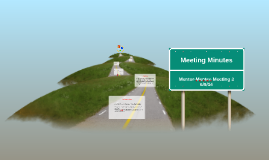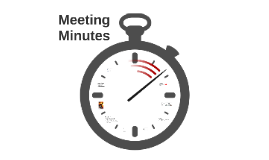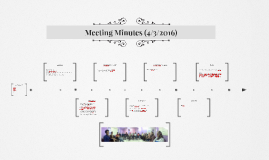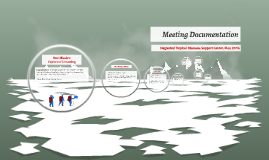Meeting Minutes
Transcript: Meeting Minutes Meetings are structured on agendas, each matter raised being given its own time and space. 1) The kind of meeting 2) The name of the society or assembly; 3) The fact that the regular chairman and secretary were present or, in their absence, the names of the persons who substituted for them. 4) All main motions or motions to bring a main question again before the assembly 5) Secondary motions that were not lost or withdrawn, in cases where it is necessary to record them for completeness or clarity 6) All points of order and appeals, whether sustained or lost, together with the reasons given by the chair for his or her ruling. 10) The hour of adjournment. Introduction Agendas and minutes are before and after pictures of the same event. The agendas document who was invited and the meeting’s intent and the minutes document who attended and what happened. Example 1. Date, time, and place of meeting 2. Names of those in attendance 3. Purpose of the meeting 4. Each issue addressed and highlights of the discussion 5. A notation of any materials handed out at the time 6. Outcome or decisions made(if an agreement was made to meet again, note place and time of next meeting) Format Meetings Minutes The record of the proceedings of a deliberative assembly is usually called the minutes, or sometimes - particularly in legislative bodies - the journal. prepared by: Maryll Irish M. Librilla BSA 2-9 D Additional rules and practices THE SIGNATURE. Minutes should be signed by the secretary and can also be signed, if the assembly wishes, by the president. FORM OF THE MINUTES. The principles stated above are illustrated in the following model form for minutes: The regular monthly meeting of the L.M. Society was held on Thursday, January 4, 20__, at 8:30 P.M., at the Society's building, the President being in the chair and the Secretary being present. The minutes of the last meeting were read and approved as corrected. The Treasurer reported the receipt of a bill from the Downs Construction Company in the amount of $5,000 for the improvements recently made in the Society's building. The question put by the chair "that the bill be paid" was adopted. Mr. Johnson, reporting on behalf of the Membership Committee, moved "that John R. Brown be admitted to membership in the Society." The motion was adopted after debate. The report of the Program Committee was received and placed on file. The special committee that was appointed to investigate and report on suitable parking facilities near the Society's building reported, through its chairman, Mrs. Smith, a resolution, which, after debate and amendment, was adopted as follows: "Resolved, That . . . [its exact words immediately before being acted upon, incorporating all amendments]." The resolution relating to the use of the Society's library by nonmembers, which was postponed from the last meeting, was then taken up. This motion and a pending amendment were laid on the table after the chair announced that the guest speaker had received a phone message which would require his early departure. The President introduced the guest speaker, Mr. James F. Mitchell, whose subject was ______________. At the conclusion of Mr. Mitchell's talk, the resolution relating to the use of the Society's library by nonmembers was taken from the table. After amendment and further debate, the resolution was adopted as follows: "Resolved, That . . . [its exact wording immediately before being finally voted on]." Mr. Gordon moved "that the Society undertake the establishment of a summer camp for boys on its lakefront property." Mrs. Thomas moved to amend [page 456] this motion by inserting the word "underprivileged" before "boys." On motion of Mr. Dorsey, the motion to establish the camp, with the pending amendment, was referred to a committee of three to be appointed by the chair with instructions to report at the next meeting. The chair appointed Messrs. Flynn, Dorsey, and Fine to the committee. The meeting adjourned at 10:05 P.M. Lashaunda Williams, Secretary

















